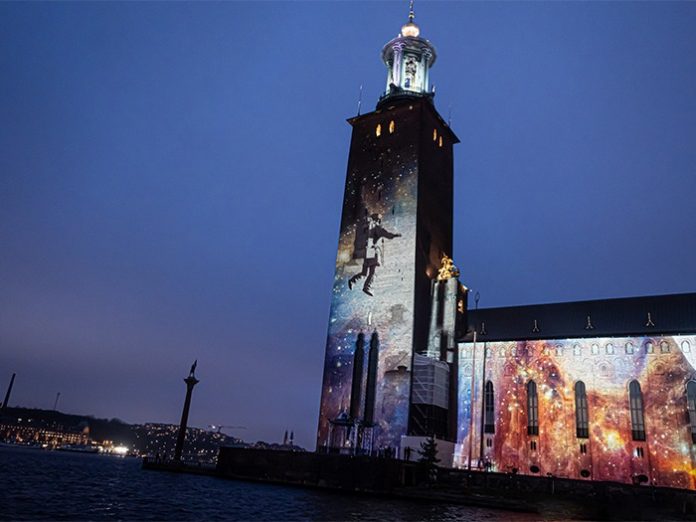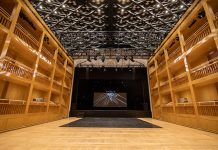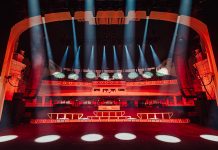Panasonic projectors have helped to celebrate man’s understanding of Space with projection mapping onto Stockholm’s iconic City Hall (Stadshuset) as part of the Nobel Week Lights festival. The installation is one of the largest video mapping projects ever seen in the city. The event was a new way to celebrate the 2020 Nobel Prize in Stockholm. Several of the lighting installations created around the city were inspired by Nobel laureate discoveries.
“Creating a projection mapped piece of art on Stockholm’s Stadshuset was one of those bucket list projects that PXLFLD creative director Andreas Skärberg and I had talked about for years,” said Anders Granström, Technical Designer at PXLFLD, the Stockholm-based creative studio. “So, when the Nobel Week Lights organisation and Lumination Of Sweden approached us for ideas for a creative installation, we instantly presented a design mock-up for Stadshuset. They loved the idea and started the administrative process to clear all necessary permits on their end.”
The creative result was SPACE, designed by Andreas Skärberg and produced by PXLFLD studios. The content is a 16 minute projection mapped, animated art installation. It is a tribute to the amazing advances within the field of space physics that The Royal Swedish Academy of Sciences has recognised with Nobel awards. The installation is inspired by scientific reference material generously provided by the Swedish National Space Agency and European Space Agency.
“We wanted to create a large scale visual experience of space anchored to the City Hall facade. SPACE connects art, animation, architecture and science presented on one of Stockholm’s most recognisable landmark buildings,” said Anders. “The installation could be observed from both near and far from multiple spots all over Stockholm, so the animations and imagery really had to be able to stand out on their own, without relying on a musical score for ambiance and effects.”
PXLFLD called on its partner Creative Technology, which specialises in advanced technical solutions for the live events and broadcast industry, to help make the vision become reality. “We were asked to supply a set-up of projectors that could cover one side of the house and the tower,” said Johan Törnström, at Creative Technology. “In this case a surface of 3200 sqm. The dark brick wall of the iconic building was one of our major concerns; that and the size of the wall. We had a limited budget and space for the projectors, but we knew that the Panasonic solution was flexible, compact and delivered enough lighting power to ensure a great quality show.”
The team deployed a total of 30 Panasonic PT-RQ22K and PT-RZ21K projectors for the display. A 20 foot long container, with two long windows for 18 of the projectors, were stacked on two levels and pointed at the wall of the building. Then two aluminum boxes, 8 foot long and containing 6 projectors each, were used to cover the tower. Initially there were some worries about cooling the block of 18 projectors but this was solved with high powered fans.
“We chose the Panasonic projectors because of the building’s many details with windows and brick formations,” explained Törnström. “We needed a laser-based projector that was easy to line up around all the sharp edges but also for the improved colour and contrast compared to a lamp-based projector. In addition, it was important that the projectors were compact and easy to set-up in the restricted space we had to use.”
Anders also added that the reliable Panasonic laser architecture was the single most important projector feature, as the installation ran over 12 days and many of the arrays were installed in portrait.
The Panasonic PT-RQ22K and PTRZ21K used are leading compact and lightweight projectors in the high-brightness class with some of the smallest footprints of any 20,000lm projector. They are extremely lightweight and easy to handle, making them perfect for live events. The projectors combine 3-Chip DLP imaging with 4K+ SOLID SHINE Laser Phosphor technology to give stunning image quality. Solid-state laser light sources and specially engineered heat-resistant phosphor wheels work together with three discrete DLP modules (R/G/B) for high brightness, true colour accuracy, and high contrast.
The initial alignment of the projector stacks was carried out using Panasonic Geometry Manager. The final mapping stage, blending and playback was made using disguise 4×4 Pro media servers. A Lightware DVI matrix was used for signal distribution and backup switching.
“The Panasonic projectors, as well as their software, were very easy to work with,” said Törnström. “Apart from securing proper ventilation, the only other challenge on-site was shadows from some ships, that were unable to move. The worst was overcome by adding a third projector situated physically in another container, on top of the two-stack that was assigned this specific part of the building.”
During the successful festival, more than 100,000 people attended the event and preparations are already underway for next year. “We’ve designed and produced a lot of projection mapping projects through the years, but this one especially stands out because of the current pandemic restrictions,” said Anders. “Being able to present this huge piece to an audience in a safe way and having the visual content take centre stage is a truly humbling experience and the public response has been overwhelmingly positive.”





